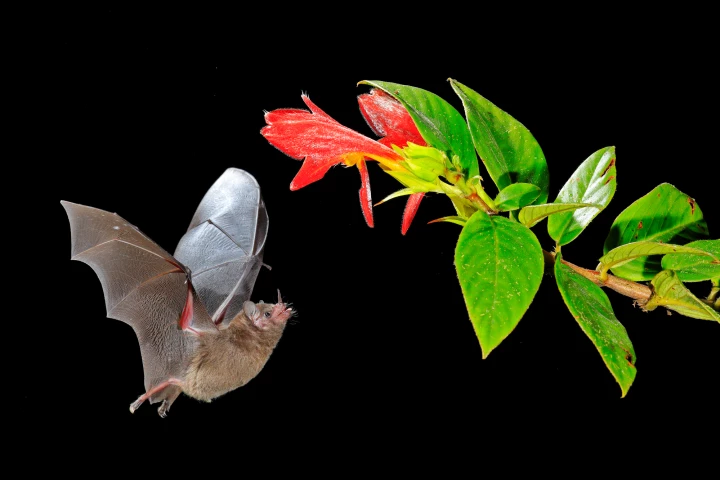Bats
-
For the first time, scientists have recorded hundreds of hippocampal cells in flying bats simultaneously to show how bats store memories not just of individual places, but as entire maps. The study could lead to cures for neurological disorders.
-
Male serotine bats living in a Dutch church attic have been captured on camera engaging in marathon sessions of non-penetrative sex, while armed with a heart-shaped penis that's seven times longer than the female's vagina. Yes, this is a true story.
-
Using high-speed infrared cameras, researchers have discovered that the whiskers on long-tongued bats help them expertly extract nectar from flowers, sometimes as quickly as a half-second. The finding could help inform conservation efforts.
-
Wind energy is often thought of as "clean" but, in fact, the technology has the blood of thousands (if not millions) of bats on its hands. A new drone-mounted system shows promise in rerouting some bats above the turbine blades and away from danger.
-
If you've ever listened to death metal rock or Mongolian throat singing, you'll be familiar with the growling vocals that are part of both. Well, bats make similar sounds, and it turns out that they do so in the same manner as human singers.
-
When we think of animals that work together to hunt prey, we typically think of creatures such as wolves or orcas. Common bats may soon be added to that list, as a new study suggests that they show each other where the tasty insects can be found.
-
Scientists studying memory and learning in frog-eating bats have made a surprising discovery, demonstrating that they can recognize ringtones tied to food rewards up to four years later, which is believed to help them hunt in the wild.
-
Greater mouse-eared bats are preyed upon by owls, but the owls themselves likely avoid hornets, for fear of getting stung. New research suggests that the bats take advantage of this fact, by buzzing like hornets to keep owls at bay.
-
Because both bats and moths are nocturnal, bats use echolocation to zero in on the insects when hunting them in the dark. A new study, however, suggests that some moths have evolved special wingtips to avoid becoming a meal.
-
For many years now, scientists have learned about the past by analyzing core samples taken from ice caps or soil. They have now applied that same technique to a millennia-old pile of bat poop, with interesting results.
-
We all know that bats locate prey in the dark using echolocation, but … is that really all there is to it? Scientists decided to get more details on the animals' hunting process, by equipping them with tiny wearable computers.
-
Scientists working in the West African country of Guinea have discovered a new orange-furred species of bat. The rare discovery came while conducting field surveys in the isolated Nimba Mountain range.
Load More











